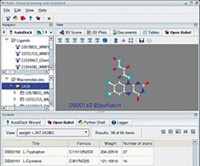Advertisement
Grab your lab coat. Let's get started
Welcome!
Welcome!
Create an account below to get 6 C&EN articles per month, receive newsletters and more - all free.
It seems this is your first time logging in online. Please enter the following information to continue.
As an ACS member you automatically get access to this site. All we need is few more details to create your reading experience.
Not you? Sign in with a different account.
Not you? Sign in with a different account.
ERROR 1
ERROR 1
ERROR 2
ERROR 2
ERROR 2
ERROR 2
ERROR 2
Password and Confirm password must match.
If you have an ACS member number, please enter it here so we can link this account to your membership. (optional)
ERROR 2
ACS values your privacy. By submitting your information, you are gaining access to C&EN and subscribing to our weekly newsletter. We use the information you provide to make your reading experience better, and we will never sell your data to third party members.
Policy
Digital Briefs
New Software and Websites for the Chemical Enterprise
by Stephen M. Trzaska
June 11, 2007
| A version of this story appeared in
Volume 85, Issue 24
Software
(1) Sarchitect Designer 2.2 is an in silico platform for building, validating, and deploying structure-activity relationship models. The application packages more than 1,000 two-dimensional and three-dimensional descriptors and offers an extensive panel of regression and classification methods. Sarchitect also provides "prebuild" ADME/Tox models for a popular set of 11 endpoints. The product uses an open model framework where underlying structures and data from models can be accessed and extended as new results become available. The platform makes an extensive use of workflows for increased productivity. Strand Life Sciences, www.strandls.com/sarchitect
DATABASES
eMolecules 2.0 is a freely accessible database that includes more than 6 million unique chemical structures, 16 million product listings, and 150 suppliers and reference sources. The database has vendor information for more than 4.2 million unique screening compounds, building blocks, and natural products. The latest version of the database has an improved user interface and a new ability to browse by chemical categories. List management allows users to save, store, and share search results, or export them in Excel, SDF, or SMILES formats for additional processing. eMolecules 2.0 supports secure browser connections with 128-bit encryption. eMolecules, www.emolecules.com
ONLINE
(2) The Wolfram Demonstrations Project is a Web collection of freely available interactive demonstrations in math and science. For researchers, educators, and professionals, the website features more than 1,000 dynamic open-code applications based on Mathematica 6 software. The Demonstrations Project is a daily growing collection with contributions on a variety of topics by users from around the world. Some demonstrations can be used in the classroom to visualize tough concepts, while other demos shed new light on cutting-edge ideas relevant to high-level workgroups. All demonstrations can be previewed on the Web and downloaded to run in Mathematica 6 or Mathematica Player, the free runtime environment for Mathematica notebook. Those with Mathematica can also experiment with and modify the code on their own computers. Wolfram Research, demonstrations.wolfram.com
(3) ChemSpider is a free chemistry search engine that has been built with the intention of aggregating and indexing chemical structures and their associated information into a single searchable repository. The database contains more than 14.5 million compounds. Many properties have been added to each of the chemical structures within the database-structure identifiers such as IUPAC names as well as many physicochemical properties. The intention of the search engine is to collect into a single database all chemical structures available within open-access and commercial databases and to provide the necessary pointers from the ChemSpider search engine to the information of interest. This service will allow users to either access the data immediately via open-access links or have the information necessary to continue their searches into commercially available systems. ChemZoo Corp., www.chemspider.com
Scitopia.org is a free search portal capable of accessing 3 million articles spanning as far back as 150 years, as well as some patents and government data. A search on Scitopia will initiate simultaneous searches on all participating publishers' websites, retrieve and merge results, and present users with a relevant ranked list of bibliographic citations and abstracts from which they can choose the full-text articles. Acquiring the full-text articles will involve authentication to licensed subscriptions or pay-per-view payments. Scitopia.org, www.scitopia.org
TEACHERS
Kitchen Chemistry is an online course exploring the link between chemistry and the culinary arts. The course is made available through Massachusetts Institute of Technology's OpenCourseWare Initiative. Visitors to the site can download the syllabus, take in some assigned readings (and recipes), and peruse the assignments. The assignments involve emulsifiers, ice cream, peer teaching, cheese, and scones and tea, among other topics. The site also includes links to related resources, such as those on chocolate, guacamole and salsa, a chemist's explanation of the use of copper bowls, and the science of pectin. MIT OpenCourseWare, ocw.mit.edu/OcwWeb/Special-Programs/SP-287Spring-2006/CourseHome/index.htm
Stephen M. Trzaska writes Digital Briefs. Information about new or revised electronic products can be sent to d-briefs@acs.org.






Join the conversation
Contact the reporter
Submit a Letter to the Editor for publication
Engage with us on Twitter